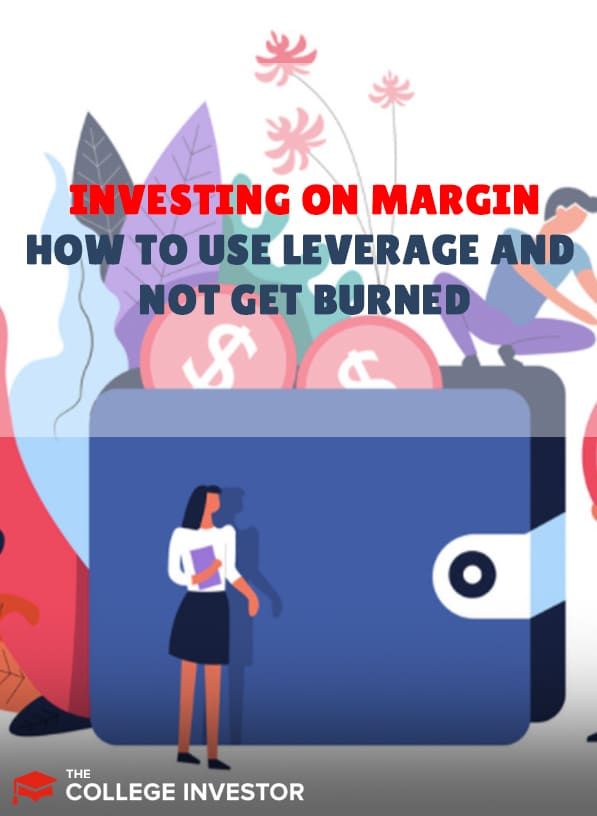
Investing on margin can present an opportunity for you to grow your portfolio more quickly. But this path is fraught with risk for investors without a game plan.
Many investors have lost all that they invested (and then some) by using margin recklessly. And the strategy has gained a deserved reputation for being dangerous.
However, it's possible to use leverage and not get burned financially. Let’s explore how to use leverage safely.
Investing On Margin, Explained
Before we can dive into the details of smart investment strategies that take advantage of leverage, let's break down how the strategy works. Essentially, investing on margin is using money that you've borrowed from your investment broker to buy investments.
Before can get started, you’ll have to apply and be approved for a margin account with your broker. Once the margin account is set up, you can use the cash and securities in your regular account as collateral to borrow more funds.
The point of investing on margin is to take advantage of potentially high returns. If you anticipate that a particular stock will rise, you may choose to use borrowed funds to buy more stock than you could otherwise. In order to make a profit, the investment must earn a higher rate of return than what is being paid in interest on the loan.
With the power to borrow more funds than you have on hand, investing on margin provides an opportunity to amplify your gains. However, this strategy can go south quickly as it will also amplify losses.
For example, let's say you invest $5,000 in ABC stock by using $2,500 in cash and $2,500 of margin. If the stock appreciates by 20% to $6,000, you'll actually make 40% on your $2,500 investment. But if the stocks falls by 20% to $4,000, you'll suffer a 40% loss.
How To Use Leverage Without Getting Burned
Now that you know a little bit more about investing on margin, it's clear that its riskier than investing with cash. However, that doesn’t mean it is always a bad idea. In fact, it can provide an opportunity for you to grow your portfolio more quickly. Let’s explore some of the strategies you can implement to avoid getting burned.
Understand Your Risk Tolerance
Investing on margin is not a good choice for everyone. A successful investor that takes advantage of margins will likely have a high risk tolerance and willingness to track their investments closely.
If you don’t have a high risk tolerance, the potential downsides of investing on margin could be too great for you to stomach. And that’s okay! Don’t dive into investing on margin if you're uncomfortable with the idea of potentially magnifying your losses.
With a higher risk tolerance, you may be more comfortable taking on the risks that come with investing on margin. That comfort level can help you stick to your investment strategy through the inevitable ups and downs.
Not sure where your risk tolerance stands? Take a look at these assessments to find out.
Learn The Ropes Of Investing First
Building an investment portfolio is an exciting prospect. As you first dive into this new world of money, take things slow. I would not recommend investing on margins until you’ve gained a solid understanding of how the market works.
Without a clear understanding of the market, it's very easy to lose money with margin investing. Want some help learning how to invest in stocks? We've got you covered. Read our guide here >>>
Cap Your Leverage
If you're chasing higher returns, it can be tempting to go "all in." After all, you believe that a particular stock will rise and net you tremendous profits. However, you'll want to avoid overextending yourself. Rather than using as much leverage as possible, set a percentage of your portfolio that you are comfortable with and stick to that.
You’ll have to decide for yourself where to cap your leverage usage. Many feel comfortable somewhere between 10% and 25%. With a cap on your leveraged opportunities, you limit the damage that can done to your portfolio when one trade goes against you.
Use Margin Sparingly
As I mentioned above, it's good to have a cap in mind whenever you use leverage. But you should probably take things a step further and avoid investing on margin too often.
When margin trading becomes a regular habit, it can be difficult to stay engaged and alert with monitoring your positions. Instead, only use margins when you find a worthwhile opportunity. With that, you'll be more likely to disciplined throughout the course of that investment cycle. This will allow you to keep everything on track to the best of your abilities.
If you aren’t able to commit the time and energy required to monitor your leveraged investments effectively, then you may want to hold off.
Set Stop-Loss Orders
One way to limit your risk when investing on margin is to set a stop-loss order right after you enter a position. By doing so, you can automatically exit a position whenever the stock falls to a level that you decide -- even if you aren't monitoring your account at the time.
While stop-loss orders are incredibly useful tools, they can't mitigate all the risk of margin trading. Stop-loss orders only execute when the market is open. So they can't get you out of a position during after-market hours, even if your stock dives well below your desired exit point in between regular market sessions.
Don’t Forget To Account For The Margin Rate
Even with a lucrative stock opportunity, the interest rate attached to your margin could effectively eliminate any potential gains. Some brokers charge lower rates than others so it can pay to shop around.
But, as general rule, one of the best ways to minimize your margin interest costs is to keep a short-term investment mindset. Investments that you plan to keep for the long haul should be purchased with cash.
Final Thoughts
Investing on margin is a riskier strategy that won't be the right path for many investors. If you prefer a more hands-off approach to investing. setting up automatic cash investments with one of our favorite robo-advisors may be a better option.
However, a conservative use of margin could be worth considering for experienced and disciplined traders. By taking a cautious approach and using safeguards like stop-loss orders you may find that the risk is worth the rewards.

Robert Farrington is America’s Millennial Money Expert® and America’s Student Loan Debt Expert™, and the founder of The College Investor, a personal finance site dedicated to helping millennials escape student loan debt to start investing and building wealth for the future. You can learn more about him on the About Page or on his personal site RobertFarrington.com.
He regularly writes about investing, student loan debt, and general personal finance topics geared toward anyone wanting to earn more, get out of debt, and start building wealth for the future.
He has been quoted in major publications, including the New York Times, Wall Street Journal, Washington Post, ABC, NBC, Today, and more. He is also a regular contributor to Forbes.
Editor: Clint Proctor Reviewed by: Chris Muller
